
The life cycle means a series of changes that goes one after the other and this is the same when it comes to software testing. In software testing, many entities go through a sequence of changes from the very beginning till the end of the process. Basically, the software testing life cycle (STLC) is a process that executes various activities while performing testing on any solution. And these activities of STLC include checking whether the developed software solution meets the software quality standards and specific requirements that were listed by the clients or not. And if there are any issues or the requirements are not matched, the software testers work with the software development team to resolve them.
Besides this, the software testing company also contacts stakeholders and some selected inner circle of people to gain insight into the product. This is a very important step in this process and it helps the process become smoother.
1. What Is Software Testing Life Cycle?
STLC is a series of activities that are performed sequentially during the testing process. This verifies that the software quality and the standard expectations are satisfied. The verification and validation of the app development are also part of the STLC process.
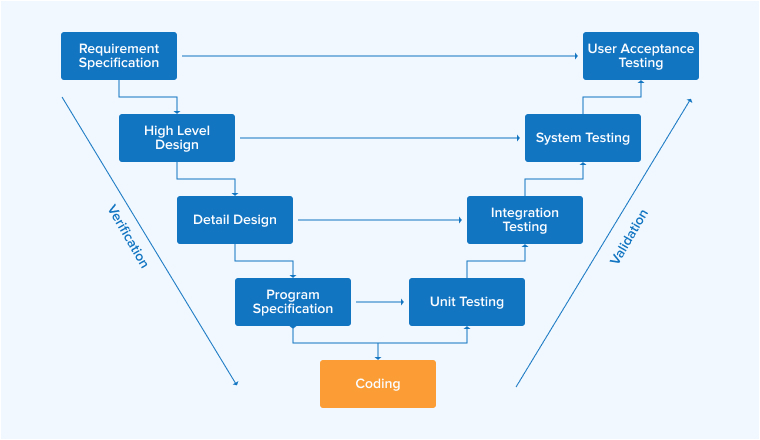
There are various STLC stages such as planning, control, implementation, standardization, and so on. These are some of the set measures of STLC. Apart from this, there is the involvement of other elements for cycle completion criteria such as test strategy, test execution, test coverage, test cases, and test case report in STLC. As a result, if you think STLC has limited functions and operations, then you are probably wrong. Because STLC has other responsibilities too other than just testing the developed product. Such as,
- In STLC, you perform testing at all stages, hence eliminating the possibility of maximizing errors. You can identify the errors at the early stages which is more beneficial for improving the process management
- Secondly, now you have all the control over the quality of the product that’s created with the testing team making the most of Agile, Scrum, SAFe, and other similar methodologies.
- This will not just ensure quality at the end but at every nook and corner of the software product.
2. Difference Between STLC(Software Testing Life Cycle) and SDLC(Software Development Life Cycle)
The way of consumption makes both STLC and SDLC different. STLC(Software Testing Life Cycle) is inside the process of SDLC(Software Development Life Cycle). SDLC is responsible for a product’s whole path from conception to completion. Testing is one of the most essential aspects of the SDLC process. The SDLC includes software testing. And this component has its own life cycle, known as STLC. But we need to know that there is a good amount of difference between these two methods. So, it’s time we must know what’s the difference between SDLC and STLC.
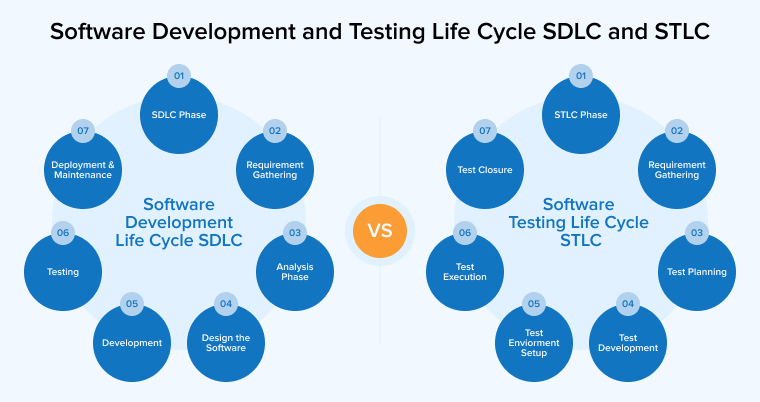
We will start with SDLC. It focuses on the creation of a product. This means it starts with understanding consumer needs and creating a product that is beneficial to them. SDLC covers aspects before the testing phase. The SDLC steps include testing as a phase in development. The end aim is to deliver a high-quality product that people can utilize. While for STLC, the test plan comes with criteria and benchmarks to meet the standards. It basically pulls off the requirements and concentrates on product testing. There are entry and exit criteria involved when you test a specific test case. A product of the SDLC process necessarily requires an understanding of the product’s development needs. They need to ensure that it performs as anticipated. The major difference is after the SDLC phases are finished, the STLC phases begin. The ultimate aim is to discover flaws in the product and submit them to the development team so they can be fixed.
Role of the STLC in the SDLC
The term “Software Testing Life Cycle” is used to describe an iterative procedure for ensuring that quality standards are satisfied. Every step of the STLC process is methodically deliberated upon and executed. The objectives and outputs of each stage vary. Although the specific phases of STLC may vary among businesses, the core concepts are universal.
We may infer that STLC contains steps like strategy, administration, execution, standardization, and so on since we can describe it as a collection of testing measures. All of this suggests that the STLC is necessary not just for testing the developed product but also for the following:
- Taking care of its flaws at the beginning when doing so will yield the greatest returns.
- Enhancing the openness and reliability of the SDLC; Having complete command over the quality of the product at all times.
- Learn how the Agile, Scrum, SAFe, etc., testing life cycle affects implementation.
- Meeting the needs of both the customer and the end users with a high-quality end result.
What the STLC does for the SDLC:
Although the Software Development Life Cycle and the Software Testing Life Cycle are inextricably intertwined, as was previously said, they focus on distinct aspects of the same overarching goal:
- Figuring out what has to be done and creating the promised features (as for the SDLC).
- Checking in on the effectiveness of the developed functionality, aiding the customer and the development team, and reviewing goals (as for the STLC).
- The end game is 100% customer approval and perfect scores in the verification and validation phases.
Incorporating an STLC allows groups to:
- Increase consistency and efficiency in the agile testing process through refinement.
- Set down your objectives and timeline for each part of the project.
- Restriction of testing time might help you find bugs faster in your project.
- Insist on successful testing of each component before moving on to the next.
- Check to see if the needs of the project have been fulfilled.
- In a Software Testing Life Cycle structure, you will often see the following steps taken:
- System requirements analysis for clients and other interested parties.
- The development of a traceability matrix (a technique for analyzing and evaluating a project’s effectiveness by contrasting needs with capabilities).
- Test cases for each feature should be identified, together with the testing methods and types that will be used.
- List desired characteristics in order of importance.
- Automation potential analysis.
- Acquiring a sense of the surrounding world through identification.
STLC’s perks include, among others:
- The practice of testing being moved to later stages of product creation. This guarantees that useful tests are created, and that feature specifications are crystal clear.
- Having a systematic approach to testing helps teams find and fix problems more quickly.
Since testing is conducted according to clearly defined phases and objectives, project development can be monitored more closely.
3. Software Testing Life Cycle (STLC) Phases
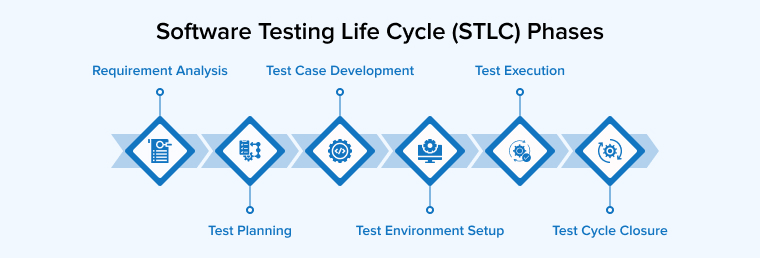
3.1 Requirement Analysis
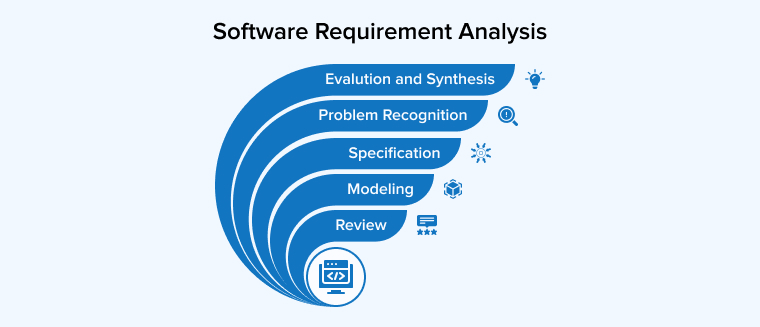
The first phase of STLC is requirement analysis. The accessible specifications and requirements must be seen, studied, and analyzed by your software testers. The test case development phase needs must be crystal clear to meet the test closure report and standards.
In this phase, you will start by feeding them with input data and some needs to create results. These are requirements that can be tested. Testers examine both the functional and non-functional requirements. If they follow that, they must choose testable requirements. In this phase itself, you need to understand whether your app is in an ideal state or not. Then check the feasibility with automated testing or manual testing, whichever is suitable as per the plan.
Once you get the requirements clear, it is time to move on the test plan.
3.2 Test Planning
The QA team produces the second phase, test planning, after assessing all of the essential testing requirements. After gaining a thorough grasp of the product domain, they define the scope and objectives.

The team then creates a test plan by analyzing the risks and defining time schedules and testing environments. You must finalize the tools for software testing and assign the roles and duties to the resources. Now, they can manage the whole testing process in a single test plan document that will describe the agenda of each test scenario and check if the test results of each part are met or not in the software testing process.
3.3 Test Case Development
3.Test case development
— kaveri (@kaveri04) July 30, 2022
In this phase QA team designs the test cases , test case review is done by peers and other concerned team members pic.twitter.com/25dSRkFUIT
Testers create and develop test cases based on the test plan. These test cases should be comprehensive and cover almost all conceivable scenarios. The business must be able to prioritize these test cases by determining which are the most prevalent and which would have the most impact on the product. In the documentation step, the defined requirements are verified and validated. The validation and verification process checks all the required sequences, updates define the pipeline of how the test team will interact. Then, based on that, they apply the testing strategy.
3.4 Test Environment Setup
For executing approved test cases, testing activities require specific environmental elements, such as servers, frameworks, hardware, and software. The major components of the test environment phase include software and hardware configuration, as well as test data preparation.
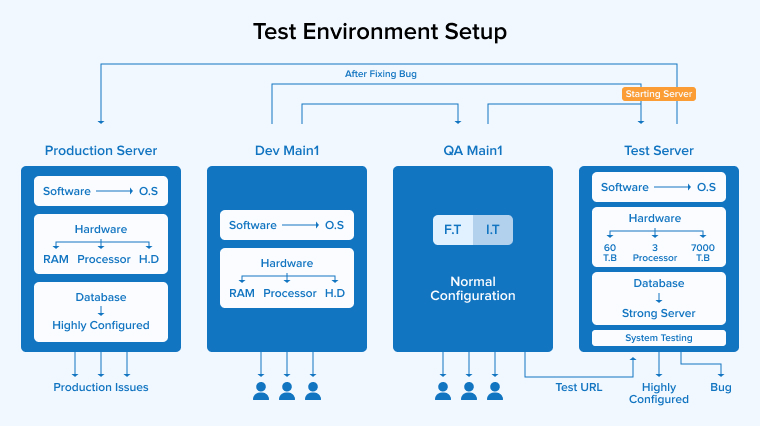
The test team studies all the requirements to perform testing. Later they will provide problem-reporting tools to your testers. The testing environment details will showcase the type of configuration setup each case will require.
3.5 Test Execution
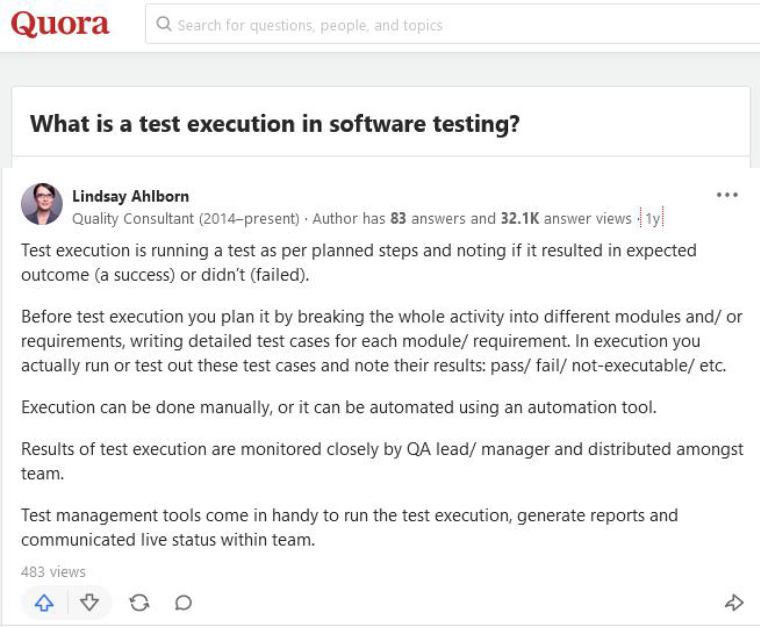
When the test team has completed all of the preceding steps, the application is ready for testing. The testers carry out test cases following the test plan. They also report problems by identifying, detecting, and logging flaws. The testing team is also in charge of comparing predicted results to actual results. If any issues are discovered, they must record them in order and forward them to the development teams for a fix. Regression testing ensures that the software or application continues to function even after the modification. After a problem is repaired, retest the entire product. It’s also advised to utilize test automation scripts or automated testing tools because the same tests must be run again after each change and release.
3.6 Test Cycle Closure
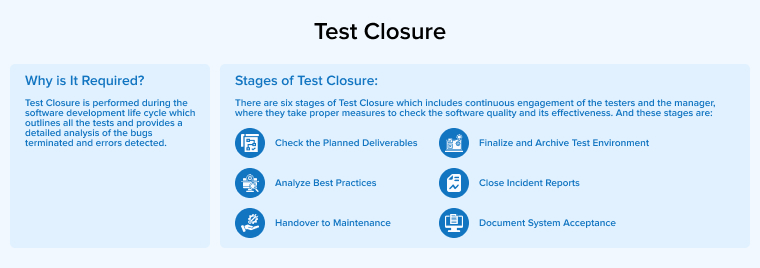
Test Closure is performed during the software development life cycle which outlines all the tests and provides a detailed analysis of the bugs terminated and errors detected.
There are six stages of Test Closure which includes continuous engagement of the testers and the manager, where they take proper measures to check the software quality and its effectiveness. And these stages are:
- Check the planned deliverables
- Analyze best practices
- Handover to maintenance
- Finalize and archive test environment
- Close incident reports
- Document system acceptance
This last phase of this cycle is to bring test closure to the test execution phase where we prepare a test closure report. The test closing phase begins when the test execution is completed and the final product is delivered. The QA team examines the test findings and confers with the rest of the team. Product quality, test coverage, and project cost are among the key criteria they evaluate. If there is a difference between the estimated and actual numbers then the tester has to go back to the procedures and check, analyze and correct them.
4. What Are the Entry and Exit Criteria for Testing Life Cycle?
The phases of a software testing life cycle (STLC) come with entry criteria or exit criteria. And this means that any tester who is working on a test case must complete it in the pre-defined time. Besides this, the test also has to maintain the functionality and quality of the product. To make this concept clear, let’s understand both entry criteria and exit criteria.
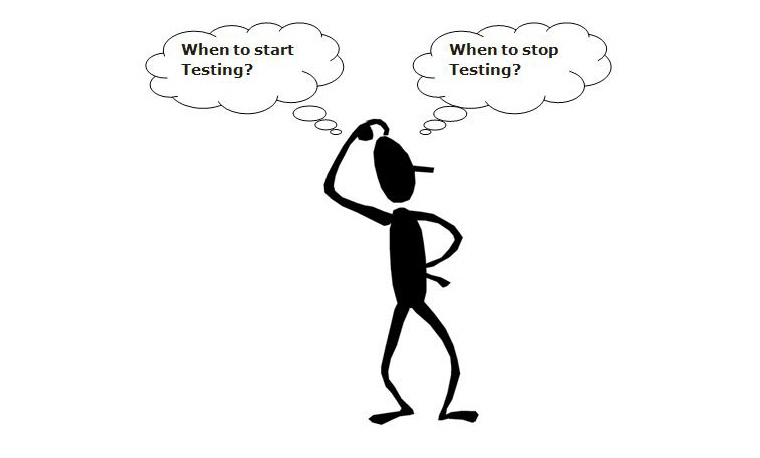
The 6 phases of the Software Testing Life Cycle are as follows:
- Requirement Analysis
- Test Planning
- Test Case Development
- Test Environment Setup
- Test Execution
- Test Cycle Closure
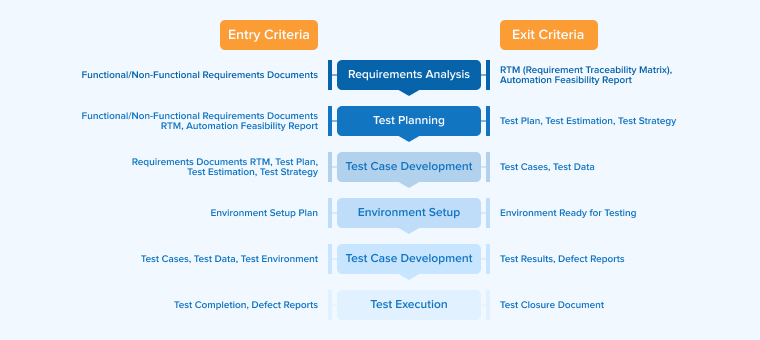
The stages mentioned above have definite Entry and Exit criteria, Activities & Deliverables associated with them. All the required documents that need to be accomplished before starting the Testing phase are given in the Entry Criteria. When it comes to Exit Criteria, it defines all the documents that must be completed before Testing can be concluded.
Every phase consists of Entry and Exit Criteria which ideally means that we cannot start the next stage until the Exit criteria for the previous stage are accomplished. But basically, this is not always possible.
4.1 Entry Criteria
Entry criteria is a phase that means that the testing team needs to take care of it before they start the testing process. This phase comes with requirements that are mandatory to cross off. Basically, it shows the conditions and activities that are present before STLC and they need to be fulfilled.
4.2 Exit Criteria
Exit criteria is a phase that needs to be taken care of after the completion of the testing process. This means that it specifies some actions and requirements to be crossed off the task list in order to complete the STLC. Before that, the testing may come to a halt. Basically, exit criteria include high-quality defect identification that needs to be fixed right away to have a perfectly successful STLC.
Best Practices of Software Testing Life Cycle
Here are some best practices followed in the Software Testing Life Cycle:
- User feedback is used to identify critical business processes which cannot be overlooked.
- Testing is effectively planned and performed to make sure that the software meets all user requirements.
- While deciding the testing scope, make sure to consult with important business users.
- Specify the common challenges and faults that might negatively affect the user experience.
- It consumes more than half of the user’s time and resources as it ensures that the testing strategy covers testing for those critical business operations.
5. Conclusion
So that’s it for the blog. In this post, we have seen how STLC works. We have given a comprehensive overview of how the software testing life cycle is different from SDLC, what is the difference, and what is its agenda. There are multiple types of software testing services that one can perform as a business and we know which one to choose for your ideal application. A good testing method boosts business results and thus, we highly advise businesses to keep their eyes on the rock(testing) while it’s sure they will get profitable results with STLC.

The software testing life cycle is a part of the software development life cycle. Which involves requirement analysis, test planning, test case development, test environment setup, test execution, and test cycle closure that ensure the software is thoroughly tested before release. Thank you for sharing this informative article with valuable resources. Sure, I will implement these practices in my upcoming project.
Great article! This article provides an overview of the software testing life cycle. It covers the different types of tests that can be performed, and provides tips for choosing the right software testing tools and techniques for a software product.
Nice way to represent this article, I really appreciate it. But I would like to suggest that if you want to make it even better, you could provide more details on the following: - Types of software testing - Writing of test cases - Some important testing tools - And many more